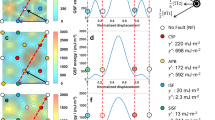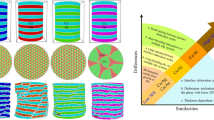Abstract
Nanocomposites have shown excellent mechanical and physical properties; however, their properties are seriously affected by the nucleation of misfit defects at the interfaces between the inclusion and the matrix. Based on the energy rule, the nucleation criteria for a misfit extended dislocation dipole (MEDD) and a misfit screw dislocation dipole (MSDD) are analytically given. Furthermore, we systematically investigate the effects of the geometrical and mechanical factors, such as the radius of the inclusion, the misfit strain, the shear modulus ratio and the stacking fault energy, on the competitive nucleation between MEDD and MSDD. It is found that the stacking fault energy has a decisive effect on the competitive nucleation of MEDD and MSDD. The critical stacking fault energy for the nucleation transferring from MSDD to MEDD increases with the increase of the shear modulus ratio and decrease of the misfit strain, while it is almost not affected by the inclusion radius.
Similar content being viewed by others
References
Karnesky, R.A., Meng, L., Dunand, D.C.: Strengthening mechanisms in aluminum containing coherent Al\(_{3}\)Sc precipitates and incoherent Al\(_{2}\)O\(_{3}\) dispersoids. Acta Mater. 55(4), 1299–1308 (2007)
Chen, J., Costan, E., Van Huis, M., Xu, Q., Zandbergen, H.: Atomic pillar-based nanoprecipitates strengthen AlMgSi alloys. Science 312(5772), 416–419 (2006)
Van der Merwe, J.H.: Misfit dislocation generation in epitaxial layers. Crit. Rev. Solid State Mater. Sci. 17(3), 187–209 (1991)
Jain, S., Harker, A., Cowley, R.: Misfit strain and misfit dislocations in lattice mismatched epitaxial layers and other systems. Philos. Mag. A 75(6), 1461–1515 (1997)
Ovid’ko, I.A.: Relaxation mechanisms in strained nanoislands. Phys. Rev. Lett. 88(4), 046103 (2002)
Freund, L.B., Suresh, S.: Thin Film Materials: Stress, Defect Formation and Surface Evolution. Cambridge University Press, Cambridge (2004)
Ovid ko, I., Sheinerman, A.: Nanoparticles as dislocation sources in nanocomposites. J. Phys. Condens. Matter 18(19), L225 (2006)
Aifantis, K.E., Kolesnikova, A.L., Romanov, A.E.: Nucleation of misfit dislocations and plastic deformation in core/shell nanowires. Philos. Mag. 87(30), 4731–4757 (2007). doi:10.1080/14786430701589350
Appel, F., Fischer, F., Clemens, H.: Precipitation twinning. Acta Mater. 55(14), 4915–4923 (2007)
Freund, L., Gosling, T.: Critical thickness condition for growth of strained quantum wires in substrate V-grooves. Appl. Phys. Lett. 66(21), 2822–2824 (1995)
Gosling, T.J., Freund, L.B.: A critical thickness condition for triangular strained quantum wires grown in V-grooves on a patterned substrate. Acta Mater. 44(1), 1–13 (1996). doi:10.1016/1359-6454(95)00173-X
Colin, J., Grilhé, J.: Surface instability and delamination of epitaxially stressed bilayers. Philos. Mag. A Phys. Condens. Matter Struct. Defects Mech. Prop. 82(13), 2609–2621 (2002). doi:10.1080/01418610210152800
Fang, Q., Liu, Y., Chen, J.: Misfit dislocation dipoles and critical parameters of buried strained nanoscale inhomogeneity. Appl. Phys. Lett. 92(12), 121923 (2008)
Fang, Q., Liu, Y., Wen, P.: Dipole of edge misfit dislocations and critical radius conditions for buried strained cylindrical inhomogeneity. Philos. Mag. 89(20), 1585–1595 (2009)
Kolesnikova, A.L., Romanov, A.E.: Misfit dislocation loops and critical parameters of quantum dots and wires. Philos. Mag. Lett. 84(8), 501–506 (2004). doi:10.1080/09500830412331305274
Gutkin, M.Y., Ovid’ko, I., Sheinerman, A.: Misfit dislocations in wire composite solids. J. Phys. Condens. Matter 12(25), 5391 (2000)
Duan, H.L., Wang, J., Huang, Z.P., Karihaloo, B.L.: Size-dependent effective elastic constants of solids containing nano-inhomogeneities with interface stress. J. Mech. Phys. Solids 53(7), 1574–1596 (2005). doi:10.1016/j.jmps.2005.02.009
Quang, H.L., He, Q.C.: Size-dependent effective thermoelastic properties of nanocomposites with spherically anisotropic phases. J. Mech. Phys. Solids 55(9), 1899–1931 (2007). doi:10.1016/j.jmps.2007.02.005
Mogilevskaya, S.G., Crouch, S.L., Stolarski, H.K., Benusiglio, A.: Equivalent inhomogeneity method for evaluating the effective elastic properties of unidirectional multi-phase composites with surface/interface effects. Int. J. Solids Struct. 47(3–4), 407–418 (2010). doi:10.1016/j.ijsolstr.2009.10.007
Zhao, Y., Fang, Q., Liu, Y.: Edge misfit dislocations in core–shell nanowire with surface/interface effects and different elastic constants. Int. J. Mech. Sci. 74, 173–184 (2013)
Fan, H., Wang, G.F.: Screw dislocation interacting with imperfect interface. Mech. Mater. 35(10), 943–953 (2003). doi:10.1016/S01676636(02)00309-5
Wang, X.: Interaction between an edge dislocation and a circular inclusion with an inhomogeneously imperfect interface. Mech. Res. Commun. 33(1), 17–25 (2006). doi:10.1016/j.mechrescom.2005.05.002
Wang, X., Pan, E., Roy, A.K.: New phenomena concerning a screw dislocation interacting with two imperfect interfaces. J. Mech. Phys. Solids 55(12), 2717–2734 (2007). doi:10.1016/j.jmps.2007.03.017
Fang, Q.H., Jin, B., Liu, Y., Liu, Y.W.: Interaction between screw dislocations and inclusions with imperfect interfaces in fiber-reinforced composites. Acta Mech. 203(1), 113–125 (2009). doi:10.1007/s00707-008-0038-2
Sudak, L.J.: On the interaction between a dislocation and a circular inhomogeneity with imperfect interface in antiplane shear. Mech. Res. Commun. 30(1), 53–59 (2003). doi:10.1016/S0093-6413(02)00352-X
Wang, X., Schiavone, P.: Interaction between an edge dislocation and a circular inhomogeneity with a mixed-type imperfect interface. Arch. Appl. Mech. (2016). doi:10.1007/s00419-016-1178-9
Fang, Q.H., Liu, Y.W.: Size-dependent elastic interaction of a screw dislocation with a circular nano-inhomogeneity incorporating interface stress. Scr. Mater. 55(1), 99–102 (2006). doi:10.1016/j.scriptamat.2006.03.026
Fang, Q.H., Liu, Y.W.: Size-dependent interaction between an edge dislocation and a nanoscale inhomogeneity with interface effects. Acta Mater. 54(16), 4213–4220 (2006). doi:10.1016/j.actamat.2006.05.012
Liu, Y.W., Fang, Q.H.: Analysis of a screw dislocation inside an inhomogeneity with interface stress. Mater. Sci. Eng. A 464(1–2), 117–123 (2007). doi:10.1016/j.msea.2007.02.057
Fang, Q.H., Liu, Y.W., Jin, B., Wen, P.H.: Interaction between a dislocation and a core–shell nanowire with interface effects. Int. J. Solids Struct. 46(6), 1539–1546 (2009). doi:10.1016/j.ijsolstr.2008.11.026
Luo, J., Xiao, Z.M.: Analysis of a screw dislocation interacting with an elliptical nano inhomogeneity. Int. J. Eng. Sci. 47(9), 883–893 (2009). doi:10.1016/j.ijengsci.2009.05.007
Shodja, H.M., Ahmadzadeh-Bakhshayesh, H., Gutkin, M.Y.: Size-dependent interaction of an edge dislocation with an elliptical nano-inhomogeneity incorporating interface effects. Int. J. Solids Struct. 49(5), 759–770 (2012). doi:10.1016/j.ijsolstr.2011.11.013
Wang, X., Schiavone, P.: Interaction of a screw dislocation with a nano-sized, arbitrarily shaped inhomogeneity with interface stresses under anti-plane deformations. Proc. R. Soc. A Math. Phys. Eng. Sci. 470(2170), 20140313 (2014)
Hirth, J.P., Lothe, J.: Theory of Dislocations, second edn. Wiley, New York (1982)
Lu, K., Lu, L., Suresh, S.: Strengthening materials by engineering coherent internal boundaries at the nanoscale. Science 324(5925), 349–352 (2009). doi:10.1126/science.1159610
Lu, L., Lu, K.: Metallic materials with nano-scale twins. Jinshu Xuebao/Acta Metall. Sin. 46(11), 1422–1427 (2010). doi:10.3724/sp.j.1037.2010.00462
Lu, L., Chen, X., Huang, X., Lu, K.: Revealing the maximum strength in nanotwinned copper. Science 323(5914), 607–610 (2009). doi:10.1126/science.1167641
Zhang, X., Romanov, A., Aifantis, E.C.: A simple physically based phenomenological model for the strengthening/softening behavior of nanotwinned copper. J. Appl. Mech. 82(12), 121005 (2015)
Roters, F., Eisenlohr, P., Hantcherli, L., Tjahjanto, D.D., Bieler, T.R., Raabe, D.: Overview of constitutive laws, kinematics, homogenization and multiscale methods in crystal plasticity finite-element modeling: theory, experiments, applications. Acta Mater. 58(4), 1152–1211 (2010). doi:10.1016/j.actamat.2009.10.058
Zou, J., Cockayne, D.: Theoretical consideration of misfit dislocation nucleation by partial dislocations in [001] strained-layer heterostructures. J. Appl. Phys. 74(2), 925–930 (1993)
Chen, M., Ma, E., Hemker, K.J., Sheng, H., Wang, Y., Cheng, X.: Deformation twinning in nanocrystalline aluminum. Science 300(5623), 1275–1277 (2003). doi:10.1126/science.1083727
Asaro, R.J., Krysl, P., Kad, B.: Deformation mechanism transitions in nanoscale fcc metals. Philos. Mag. Lett. 83(12), 733–743 (2003)
Rockenberger, J., Tröger, L., Rogach, A.L., Tischer, M., Grundmann, M., Eychmüller, A., Weller, H.: The contribution of particle core and surface to strain, disorder and vibrations in thiolcapped CdTe nanocrystals. J. Chem. Phys. 108(18), 7807–7815 (1998)
Dundurs, J., Mura, T.: Interaction between an edge dislocation and a circular inclusion. J. Mech. Phys. Solids 12(3), 177–189 (1964)
Dundurs, J.: Elastic interaction of dislocations with inhomogeneities. Math. Theory Dislocat, 70–115 (1969)
Smith, E.: The interaction between dislocations and inhomogeneities—I. Int. J. Eng. Sci. 6(3), 129–143 (1968)
Author information
Authors and Affiliations
Corresponding author
Rights and permissions
About this article
Cite this article
Zhao, J., Liu, J., Kang, G. et al. The competitive nucleation of misfit dislocation dipole and misfit extended dislocation dipole in nanocomposites. Acta Mech 228, 2541–2554 (2017). https://doi.org/10.1007/s00707-017-1840-5
Received:
Published:
Issue Date:
DOI: https://doi.org/10.1007/s00707-017-1840-5




